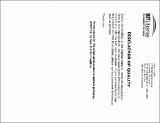Nanofiber characterization of self-assembling peptides RAD16 and RID 12
Author(s)
Charlton, Devon, 1982-
DownloadFull printable version (1.149Mb)
Other Contributors
Massachusetts Institute of Technology. Dept. of Materials Science and Engineering.
Advisor
Shuguang Zhang.
Terms of use
Metadata
Show full item recordAbstract
Self-assembling peptides are quickly proving themselves useful in tissue engineering and most recently, electronics. Self-assembling peptides have been shown to form a network of nanofibers that can be used in scaffold research or as templates for nanowires. However, self-assembling peptides have not been widely studied and further research is needed to fully understand the properties and organization of the peptide hydrogels. Much research has been conducted with single cell type scaffolds; however, the next step is to develop multiple cell type scaffolds. In addressing this next step, I studied mixtures of in-solution peptides using atomic force microscopy to characterize nanofiber formation. My results showed that when RID12 peptide was introduced into a mixture with RAD16 peptide, there was a decrease in the average fiber length. Increasing the percentage of RID12 resulted in a further decrease in fiber length. Presumably, RID12 interacts with RAD16, thereby disrupting fiber elongation. Further research is necessary to understand this interaction.
Description
Thesis (S.B.)--Massachusetts Institute of Technology, Dept. of Materials Science and Engineering, 2004. Includes bibliographical references (leaves 19-20).
Date issued
2004Department
Massachusetts Institute of Technology. Department of Materials Science and EngineeringPublisher
Massachusetts Institute of Technology
Keywords
Materials Science and Engineering.